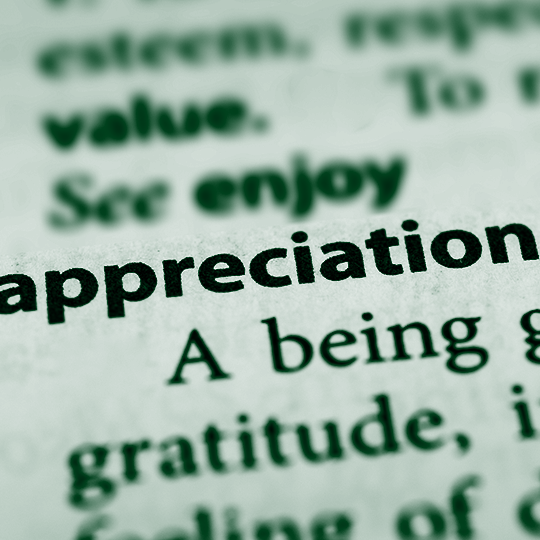Why saying thanks is more than just good manners!
By Amanda Kirby, Account Executive/Strategist
Someone once said, “Feeling gratitude and not expressing it is like wrapping a present and not giving it.” After all, who doesn’t like to hear that their gift or support is appreciated and makes a difference? That’s why I want to share 5 best practices for crafting meaningful thank you letters.
Donor appreciation is a critical component of any successful nonprofit organization. The extraordinary work you do to feed the hungry, shelter the homeless and care for hurting people in your community is only possible with the financial support of your donors!
A key piece of that donor appreciation puzzle is the Thank You Letter. Today, I want to challenge you to internalize these 5 best practices when writing thank you letters… so your letters will work a little harder to engage donors… so you share your message and your heart more clearly… and, most importantly, so you can show your appreciation for the folks who are part of your everyday miracles!
1. Thank You 101
A Thank You Letter or Receipt acknowledges a donor’s gift and provides them with a receipt for bookkeeping or tax purposes. It can also act as an invitation for the donor to give again, strengthening the relationship and their commitment to your cause.
In the mail, you can create a simple Thank You package that includes (1) A letter from the CEO or Executive Director, (2) a Receipt that details the donor’s information, gift amount and gift date, and (3) a Reply Form with a soft ask that gives the donor a chance to give again.
For online donations, communicate your thanks with an email. This email can be automated and should include the donor’s information and gift amount. An automated email thank you should feel just as sincere as a more customized thank you letter in the mail.
These donors just gave their hard-earned money to your ministry. So their personal thank you should be filled with warm, grateful language showing the impact of their gift and making them feel oh-so-special!
2. On Time, Every Time
Did you know one of the top reasons a donor becomes lapsed is because they were not thanked for their gift? This is heartbreaking because it’s such an easy problem to avoid simply by reaching out with a thank you letter.
We recommend sending thank you receipts between 24-48 hours from receiving a gift. You want to get this into their hands as quickly as possible, while the donation is still fresh in their mind and they are feeling good about their philanthropy.
When someone makes a gift online, you can set up an automated email thank you to ensure their gift is acknowledged quickly. Just like the etiquette our grandmothers were taught, the sooner you get out that thank you letter, the better!
3. It’s All in the Details
Did a donor respond to an Easter campaign? Perhaps there was something in your Easter message that really resonated with that person. This is a great opportunity to be specific and show how far a donor’s gift can go during this particular timeframe.
Show the impact of their gift by sharing how many meals are served over the Easter season… highlighting why their gift was especially needed during this busy weekend… or celebrating the lives changed during this time of miracles!
Tailor your letter so that it feels personal and speaks to the season. Donors want to feel like this is not some basic form letter… really show them that their gift went to help during this campaign that motivated them to open their hearts and their wallets!
4. The Start of a Beautiful Friendship
Did you receive a gift from a donor for the first time? This is your chance to welcome New Donors to your family of Mission supporters and share more about your organization to help motivate that all-important second gift!
- Highlight other opportunities to give (such as monthly giving or Donor Advised Funds).
- Feature different ways they can get involved in your ministry (such as upcoming volunteer opportunities or signing up to take a tour of your facility).
- Include a brochure or the latest copy of your newsletter to share a little more about what’s happening at your organization.
And most importantly, don’t be afraid to include an opportunity for the donor to give again. Data shows that the sooner a new donor gives their second gift, the higher their retention rate and lifetime value! (A donor who gives their second gift in the first 0-3 months has DOUBLE the Five-Year Value of a donor who waits to give their second gift 1+ year later.)
For larger gifts from Major Donors, a handwritten note or phone call can go a long way. These donors often have a higher capacity and propensity to give – so don’t leave money on the table simply because you didn’t nurture the relationship!
- Invite them for a tour of the Mission, preferably one-on-one with your Executive Director or CEO.
- Share some updates on a major project you are working on (such as a capital campaign or renovation) so they understand how their gift is put to work.
- Engage with these major donors – find out, what are their passions? What do they love about supporting the Mission?
A thoughtful thank you to a Major Donor can be the beginning of a key partnership with the Mission! Likewise, if a large gift goes unrecognized, it could hurt a relationship with a partner that could be costly to the organization.
5. Share What’s on Your Mind
Do you have an event coming up that you’d like to promote? Or perhaps you’re looking to grow your sustaining Monthly Donor Club? Maybe there’s a new program you’re excited about, or a critical need the Mission is facing. (Rising cost of food and gas, anyone?)
You’re already sending this communication – why not make it work extra hard and share something to encourage the donor to continue their involvement with the Mission?
Here’s a secret… The P.S. line is a great way to share an added message. Better yet, a simple insert can really draw the donor’s attention and stand out in a package!
After all that, I’d be remiss if I didn’t say “THANK YOU” for reading this article. I hope these 5 ideas and best practices to craft meaningful thank you letters have been helpful… and will inspire you to spread gratitude in a big new way!
Looking for more information on this topic or want to partner on a Donor Appreciation strategy? Reach out to your BDI Strategist or click “Let’s Talk”!
Check out last week’s Quick Shot – “Nonprofits need to hire good legal counsel”>>




